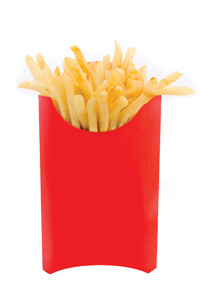If you’ve ever slowed down at the Golden Arches on a hectic day, maybe you can relate to Natalie Kryger. The Snoqualmie mom — with four homeschooled boys younger than age 12! — is committed, along with her husband, Nathan, to raising healthy sons,. The family has an active lifestyle, featuring lots of outdoor activities and sports. So Natalie feels the irony every time she steers her boy-laden car through a fast-food drive-through for a quick meal fix.
 Busy families often find fast food a hard habit to break. But, although it takes more work to avoid fast food, the effort is worth it, according to David Hill, M.D., a North Carolina parent of three and a pediatrics expert on JustAnswer.com. “We know that children who are obese turn into obese adults,” he says, “so you can literally add years to your child’s life by making good dietary decisions from a young age.”
Busy families often find fast food a hard habit to break. But, although it takes more work to avoid fast food, the effort is worth it, according to David Hill, M.D., a North Carolina parent of three and a pediatrics expert on JustAnswer.com. “We know that children who are obese turn into obese adults,” he says, “so you can literally add years to your child’s life by making good dietary decisions from a young age.”
C’mon, get happy
“Fast-food restaurants have perfected the art of making people happy by loading on the salt, saturated fat and carbohydrates,” Hill says, noting that a Meal Deal at McDonald’s can contain more calories than the average adult needs for an entire day. Experts now know that processes like atherosclerosis (hardening of the arteries) begin during childhood — even though the symptoms don’t appear until much later. “We also know childhood is a critical window for developing eating habits that will persist throughout life,” Hill says. “Helping children learn to crave the flavors of whole, fresh foods rather than processed foods will serve them for decades to come.”
So how many Happy Meals does a happy family make? “Honestly, four Happy Meals a month is probably pushing it,” says Hill, whose own family occasionally partakes. “In the dietary world, pretty much nothing is altogether off limits, and fast food is fine as an occasional treat. In our own family, we have yet to take a road trip without at least one stop at the Golden Arches.”
Plan ahead
What’s the secret to staying away from fast food? Planning ahead! Bastyr Center for Natural Health nutrition director Kelly Morrow, M.S., R.D., recommends loading up your car with nutritious snacks and beverages in advance. Morrow also suggests a visit to your local grocery store’s health food aisle (they all have ’em!) for snacks that are packaged but less processed. Fruit, whole grain crackers, cheese, nuts, peanut butter or almond butter with honey or jam sandwiches, water and organic milk cartons can all be tossed in a cooler and help you avoid a fast-food stop.
If you must stop for a quick meal, Morrow suggests choosing somewhere that offers healthier food options, such as Subway, Taco Del Mar, PCC, Whole Foods, Madison Market Deli, Qdoba, Chipotle and Quiznos. All offer healthier options; choose items made with whole grains, beans and vegetables.
There are even alternatives to those fast-food play areas. When Morrow’s own 6-year-old needs to run off some steam, she takes him to the downtown REI store to enjoy its tree house play area, followed by a visit for a healthy meal at World Wrapps.
You can also avoid a fast-food stop by making and freezing several meals in advance, suggests Issaquah mom, chef and teacher Karista Bennett. “I always recommend my students to take at least an hour over the weekend, or when it’s convenient, and plan a few days’ worth of meals at a time,” Bennett says.
Drinky-poo
Don’t overlook that nutritional black hole — sugary beverages. “One of the most important things to consider is what kids are drinking between meals,” says Mary Jones Verbovski, a pediatric dietitian at Seattle Children’s Hospital. “Water is best. Juice is often best diluted by 50 percent with water, particularly with preschool ages. If drinks that have calories and sugar are sipped on between meals and snacks, the body doesn’t have the chance to get a break from insulin, which circulates when glucose is present in the bloodstream. This means, the hunger signals are possibly confused or suppressed leading to meal and snack times having less or more food than if there is adequate hunger built between meals and snacks.”
For her part, Kryger says that although her kids do occasionally still eat fast food, sit- down family dinners are top priority. Research shows that children who are raised with a sit-down family dinner tradition are less likely to abuse drugs and alcohol, and more likely to grow up with healthier eating habits. Kryger is trying to plan ahead and serve dinner earlier on days when her boys have evening sports practices. It takes more effort, she knows, but it will pay off in long-term health benefits — and happy memories.
Kathleen F. Miller packs water, sandwiches and fruit for her kids’ summer meals at the beach or pool, but also frequently stops for Dairy Queen ice cream cones on the way home.
RESOURCES
Books
Feeding the Whole Family by Bastryr and UW Faculty member Cynthia Lair
Secrets of Feeding A Healthy Family by Ellyn Satter
The Unhealthy Truth: How Our Food Is Making Us Sick And What We Can Do About It by Robyn O’Brien
Web sites
Local mom and chef Karista Bennett offers easy, make ahead healthy meal ideas on her Web site Easy Everyday Gourmet.
Cynthia Lair’s Web site, Cookus Interruptus, offers recipe ideas for cooking local organic whole foods.
Classes
PCC Natural Markets offers cooking classes for parents and kids.











